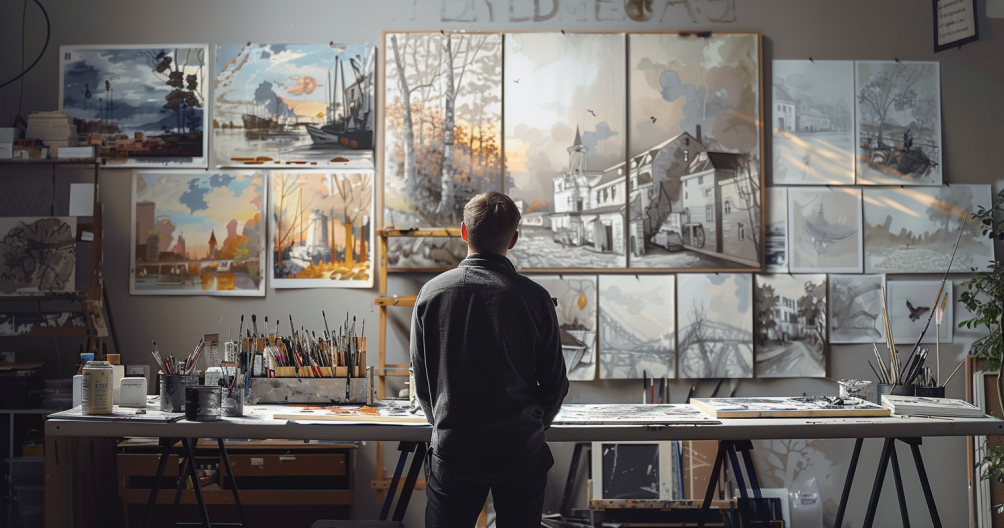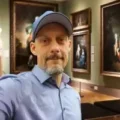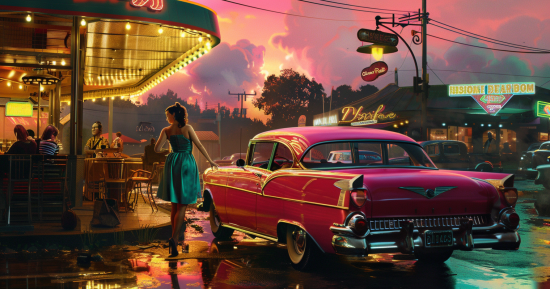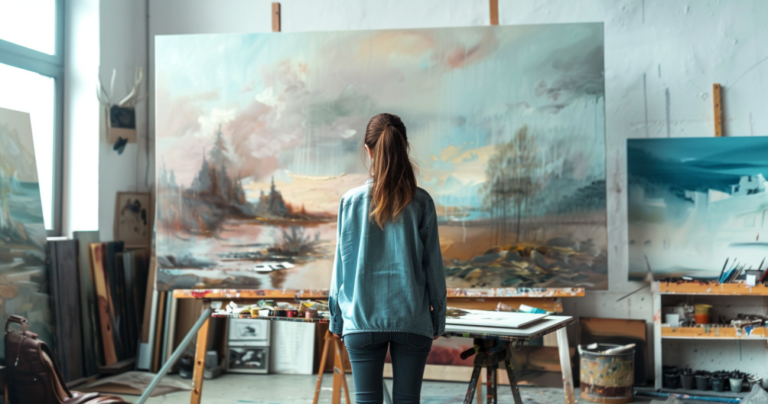Find art style. Discovering your unique artistic style might seem daunting at first, but with curiosity and determination, it can turn into a rewarding journey of self-discovery. Your creative approach reflects your individuality, providing a medium to express your perspective and personality through visual art.
To guide you on this path, here are some suggestions on how to find your art style, tailored towards helping you establish a distinct artistic identity that resonates with your intentions and emotions.
Start Exploring to Find Art Style
Begin by exploring different artistic genres to draw inspiration from various sources, such as looking through art books, visiting art museums, and browsing online galleries. Remember to keep an open mind, as sometimes, inspiration emerges from unexpected places.
You can learn more about different art styles by analyzing your own artwork, seeking out common themes, motifs, and techniques. By experimenting with diverse mediums and forms, you’ll get a better understanding of your preferences and discover the techniques that resonate with you the most.
As you progress on your artistic journey, allow your personal art style to evolve naturally and enjoy the creative process. It’s essential to find a balance between drawing influence from other artists and letting your own voice shine through. Embrace your growth as an artist, and don’t be afraid to push your boundaries, as this will contribute to the development of a strong and uniquely recognizable art style.
Understanding Art Styles
Definition of Art Styles
An art style refers to the unique visual characteristics that define an artist’s work or a particular artistic movement. It encompasses elements such as color, line, shape, texture, and composition to create a distinguishable aesthetic. Understanding various art styles is a crucial step in discovering how to find your art style.
Types of Art Styles

Here are some popular art styles that can serve as a starting point for developing your unique style:
- Impressionism:
Characterized by short brush strokes, open composition, and an emphasis on capturing the essence of the subject. Notable artists include Claude Monet and Pierre-Auguste Renoir. - Expressionism:
This style focuses on evoking emotion through exaggerated colors, shapes, and brushstrokes. Famous artists associated with this style are Vincent van Gogh and Edvard Munch. - Realism:
As the name suggests, realism aims to depict subjects as they appear in real life, with great detail and accuracy. Jean-François Millet and Gustave Courbet are examples of realist artists. - Abstract:
Abstract art does not represent objects in an accurate or recognizable way but uses shapes, colors, and forms to convey ideas or feelings. Prominent abstract artists include Wassily Kandinsky and Piet Mondrian.
Understanding these different styles can help guide you in finding your artistic preferences. Keep experimenting with different techniques and subjects, and over time, your unique art style will begin to emerge.
Personal Artistic Growth
Artistic Experimentation
For personal artistic growth, it’s essential to engage in artistic experimentation. Trying out various mediums, techniques, and styles can help you find what works best for you. Don’t limit yourself to one style yet, as exploring styles like Impressionism, Painterly Realism, Art Deco, and Abstract may give you the inspiration and understanding needed to carve your unique path.
A great way to experiment is by:
- Using different materials:
Experiment with various types of paints, sketching tools, or even digital art tools. - Creating different subject matter:
Diversify the topics you depict in your art, from landscapes to portraits to abstract concepts. - Copying various artists’ techniques:
Gain a deeper understanding of other artists’ techniques by creating studies or interpretations of their work.
Finding Inspiration
In addition to experimentation, finding inspiration is key to developing your art style. Your surroundings can offer a plethora of sources to ignite creativity. Observe flora and fauna, buildings, and everyday people for a starting point. However, don’t limit your sources of inspiration to just local scenery; research other cultures and historical art movements to enrich your artistic vocabulary.
Here are some potential sources of inspiration:
- Other artists:
Study the works of classical painters, comic artists, and commercial illustrators, while also staying open to contemporary artists. - Personal experiences and passions:
Your own life experiences, dreams, and hobbies can influence your artistic style immensely. Don’t shy away from incorporating your values, emotions, and memories into your art. - Nature:
Explore landscapes, animals, and plants to tap into the colors, shapes, and textures nature provides.
Remember, your art style is a journey of discovery. Maintain the spirit of experimentation and embrace diverse sources of inspiration to cultivate your unique artistic voice.
Analyzing Famous Art Styles

Influence of Famous Artists
Studying the work of artists you admire can help you to find your art style. By analyzing their techniques, mediums, and subjects, you’ll be able to gain insights into how they developed their unique styles. To do this effectively, consider the following approaches:
- Books:
Read biographies or books about your favorite artists to understand their art styles and artistic influences. - Virtual study:
If you can’t visit museums or galleries, access online resources such as museum websites or virtual galleries. - Art classes:
Participate in art classes or workshops focused on specific styles or artists to learn and adapt their techniques.
By doing these, you’ll be able to identify the key elements that make an artist’s work distinct and consider which aspects appeal to you personally.
Adapting Different Art Styles
When looking for your art style, don’t be afraid to combine different styles together. This can result in a unique fusion that reflects your creative vision. Here are some tips to help you do this:
- Experiment with different mediums:
Try working with various materials such as acrylics, watercolors, or digital tools to see how each medium affects the style of your artwork. - Combine techniques:
Merge techniques from different art styles, like incorporating impressionist brushstrokes into a realistic scene. - Find inspiration from various sources:
Travel to new places, visit local galleries, or browse through different types of art online to discover new styles that might resonate with you. - Practice:
To gain confidence in your style, practice combining different styles in your artwork. Keep refining your technique until you find a balance that works for you.
Incorporating elements from different art styles will not only help you develop your unique style but also expand your artistic vocabulary. Take your time and enjoy the process of finding your personal art style.
Developing Your Personal Style

Practice Makes Perfect
To find your unique art style, it’s crucial to practice regularly and study different styles and mediums. Experimenting with various techniques helps you discover what resonates with you. For example:
- Try traditional methods like charcoal, acrylics, or watercolors
- Explore digital art using software like Photoshop or Illustrator
- Mix media by combining traditional and digital elements in your work
While exploring different art styles, remember to enjoy the creative process and let your personal style develop naturally over time. It’s essential to be patient, as finding your art style might require a combination of practice, analysis, and a keen eye for patterns in your own work.
The Role of Critique
Constructive feedback plays a significant role in developing your signature art style. Receiving input from others, such as fellow artists or mentors, can help identify strengths and areas for improvement. Here’s how to benefit from critiques:
- Ask for feedback from trustworthy sources, like art teachers or experienced artists.
- Be open to criticism, as it can lead to personal growth and a better understanding of your style.
- Reflect on the input received and implement suggested changes in your future work.
Critique can also help inform your decisions about which styles or techniques to pursue. It’s important to balance external opinions with your own instincts, as you are ultimately the one who determines your artistic path.
Successful artists have built their individual styles through continuous practice, exploration, and constructive criticism. By embracing this process and dedicating the time and effort to experimentation, you’ll be well on your way to discovering and developing your own unique art style.
Empowerment Through Style
When you find your unique art style, it not only sets you apart from other artists, but can be a source of empowerment. Your style allows others to recognize your work and appreciate the distinct characteristics you bring to the art world. In this section, we will explore how finding and evolving your art style can promote and enhance your skills as an artist.
Promoting Your Art Style
Promoting your art style effectively is essential for reaching a broader audience and building a reputation in the art world. By doing so, you develop a distinctive voice and add value to the community. Here are some steps to help you find and promote your art style:
- Analyze your work:
Look for recurring themes, techniques, or motifs in your art and take note of any patterns you recognize. This can lead to discovering your artistic preferences. - Experiment with different styles:
Test out various art styles, techniques, and mediums – don’t limit yourself to just one. A diverse set of experiences can be vital for finding your unique style. - Share your work:
Showcase your art on social media, online galleries, and at exhibitions regularly. This will allow you to foster a community, gather feedback, and learn from other artists.
The Evolution of Your Style

Your art style is not stagnant. As you grow and learn as an artist, your style is likely to evolve. This process plays an essential role in personal and artistic growth. Let’s explore how to grow and adapt your style:
- Increase your inspirations:
Always continue exploring your surroundings, looking at different artists, and experimenting with new subjects. This keeps your perspective fresh and influences your style over time. - Practice and refine:
The more you create, the more proficient you will become at your craft. Dedicate time to improving specific techniques or mastering new ones. - Embrace change:
Art style development is typically an ongoing process. As your skills and interests change, so will your style. Accepting this evolution can lead to gaining a deeper understanding of yourself as an artist.
By understanding the importance of promoting and evolving your art style, you will unlock a new level of creative freedom and expression. So, don’t hesitate to continue honing your signature style and sharing your unique perspective.
What do you think about the art style? Feel free to write it in the comment function?
FAQ – How to Find Art Style
How do I find my unique artist style?
Finding your unique artist style involves experimenting with different techniques, mediums, and subjects. Explore various artistic influences, practice regularly, and reflect on what resonates with you. Embrace your individuality, be open to new ideas, and allow your style to evolve naturally through creative exploration and self-expression.
How do you study an artist’s art style?
To study an artist’s style, analyze their use of color, brushwork, composition, and subject matter. Research their influences, historical context, and artistic development. Practice emulating their techniques to gain insight into their creative process. Observe and deconstruct their work to understand the underlying principles that define their unique style.
What does your art style say about you?
Your art style reflects your creativity, personality, and perspective. It communicates your emotions, experiences, and values. The choices of subject matter, color palette, and techniques convey aspects of your identity and evoke unique interpretations, offering insight into your artistic expression and individuality.






